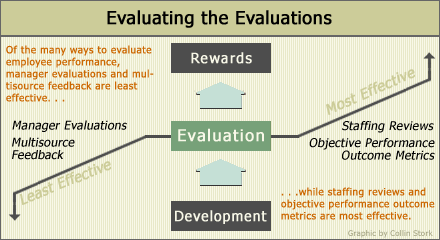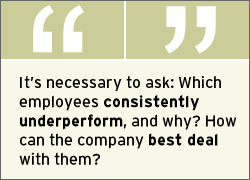The first article in this series pointed out the limitations of two commonly used approaches to performance evaluations: manager evaluations and multisource feedback. Both methods are subjective and usually fail to generate the results companies are seeking. (See "Evaluating Employee Performance [Part 1]" in See Also.)
This article will focus on two approaches to performance evaluations that are more effective: staffing reviews and the use of objective performance outcome metrics. These are not mutually exclusive; they can be used in combination with others. But companies that build their employee evaluations on these two approaches are more likely to realize gains in employee productivity and performance.
Staffing reviews
Staffing reviews are management team meetings in which managers rank, evaluate, and discuss the employees in the organization. As with any methodology, staffing reviews can have some negative effects, but when they are properly implemented, they can be quite potent.
Here's how they work: Prior to the staffing review session, each participating manager lists the names of the employees he or she supervises. As objectively as possible -- and using a good balance of valid performance measures -- the managers then group those employees into three categories: top, middle, and bottom performers. (Sometimes a fourth category is included for employees who are new to their positions.)

In the meeting, each manager goes through his or her list and shares the names that appear in each category. As they discuss and justify their classifications, others on the management team may challenge the manager when they have a different perspective on or evaluation of an employee. The management team incorporates any reclassifications and arrives at a final grouping of the employees by their level of performance.
Force-ranking employees into top-, middle-, and bottom-performing groups has intensified this process in some companies. General Electric sorts employees into these three categories, then systematically weeds out the bottom 10%. Other companies have adopted forced-ranking evaluation systems too, including IBM, Hewlett-Packard, Ford, and Sun Microsystems.
To be sure, this forced-ranking evaluation method is controversial. Although it actively differentiates performance in the workplace, studies have shown that it has negative side effects: Forcing the identification of a given proportion of bottom performers -- even in top-performing teams -- can alienate some employees and impede their development. But forcing a fixed proportion of employees into performance categories may not be necessary. The key to effective staffing reviews is not in the ranking, but in the discussions about it.
There are three aspects to the staffing review process that make it a best practice.
1. Increasing transparency. Although the managers are asked to evaluate or rank-order the employees in the organization, they must defend their judgments to their peers. This intensifies the process as compared to an appraisal that stays between the manager, the employee, and the HR department. The discussion within the management team reduces some of the subjectivity and frequently increases the credibility of the evaluations as well.
2. Driving the development of talent. The moderator or management team leader will ask questions like these:
- What qualities do our top performers have, and what do they do that sets them apart?
- What must the company do to keep them?
- How can we support them and help them develop and grow?
At the same time, it's also necessary to ask: Which employees consistently underperform, and why? How can the company best deal with them?
All of these are crucial questions leaders should address on a regular basis. Without a formal staffing review process, however, questions like these usually aren't asked, let alone focused on.
3. Increasing accountability. Review sessions are usually conducted two to four times a year. In these sessions, managers reveal and discuss employees' performance. They may also decide to promote high-potential employees across business units, put a number of top performers on special assignments, or recast employees who have been underperforming. One or two quarters later, the same process takes place, and any lack of follow through will be blatantly visible to the management team. When executed well, staffing reviews may be your most effective approach to holding employees accountable.
 |
One warning: Staffing reviews don't work with executive teams that are out of touch with their employees. But when the sessions are grounded in ongoing, one-on-one performance conversations between managers and employees, enlarging the discussion to include the management team adds tremendous value to identifying and managing talent and establishing accountability.
Performance measurement
Using a measurement-based performance appraisal process is the most objective approach to evaluating employees. One of its significant advantages is that it makes the process predictable for employees; they'll know just what they need to do to earn rewards. And placing the focus on objective financial, productivity, quality, or customer outcomes is much more useful than focusing employees on pleasing their managers.
Clearly, the challenge is to measure the right outcomes and to balance them properly for each role. Every measure has a downside, so a balanced approach usually provides a more accurate way to quantify an employee's performance. For instance, a metric that reflects a salesperson's revenue generation won't reveal anything about the quality of that rep's customer relationships or the loyalty he or she inspires. For that, managers must include measures of loyalty and customer engagement as part of the overall scorecard. Similarly, a scorecard that measures a service department on the sheer number of cars it repairs -- but fails to include a measure of how many cars were later returned because they were not correctly fixed -- could drive the wrong behavior.
Of course, it's easier to quantify performance for some roles than it is for others. Companies generally have much more rigorous measures of a salesperson's performance than of a receptionist's; where reps have quotas, receptionists don't generally have obvious outcome metrics. However, objective performance measurement is possible more often than not if managers would just look for outcomes to measure. When solid measures are identified and employees are focused on and rewarded directly for improving their measured performance, the result is usually a refreshing degree of dedication and persistence, as well as high levels of ownership and engagement.
Measurement-based scorecards usually reveal a wide variance among employee performance levels; without an objective standard, companies may not be aware where performance gaps exist. In a well-differentiated pay-for-performance system, this range ensures significantly greater rewards for top performers than it does for bottom performers, which in turn helps your company retain your top performers and sort out those who don't perform. (See "Giving Them What They Deserve" in See Also.)
Characteristics of high-performing companies
To review, highly successful performance-driven companies often shy away from subjective manager appraisals and multisource feedback. Surveys like 360s, if they are used at all, are best used as development tools, not as part of a performance management system.
Instead, the best performance-driven companies are outcomes-focused. They define and rigorously measure success at every level in the organization. Those measures ultimately help focus every person, team, department, and business unit on driving performance and results.
At the same time, the performance management process encourages an ongoing dialogue between managers and employees, and managers share these insights with management teams during staffing reviews. Conducting periodic staffing reviews gives management teams the opportunity and discipline to discuss their company's top and bottom performers, how to support and develop their top players, and how to deal with the ones who underperform.
Staffing reviews and the use of objective performance metrics are by no means the easiest ways to evaluate employees. But they are by far the most effective ways to establish a performance-driven culture that delivers results.